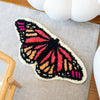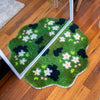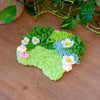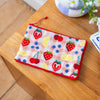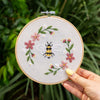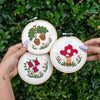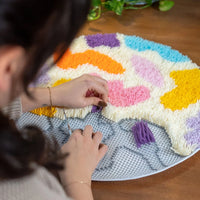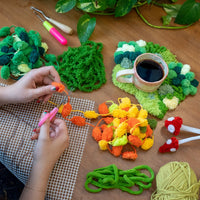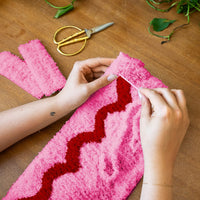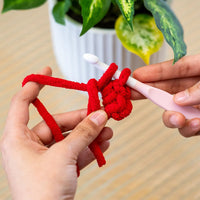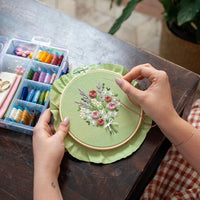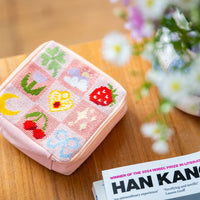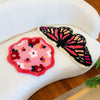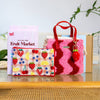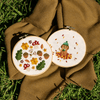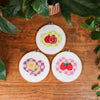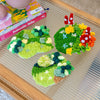Step by Step Guides
Floral Minis
Welcome to our step by step guide for your Floral Minis embroidery kit! I'm so grateful that you've chosen to try embroidery with one of our kits.
This step-by-step guide can be used in addition to or instead of your paper instructions. The benefit of this guide is that each stitch tutorial is listed below, making it even easier to complete your piece without stress!
If you find yourself having any trouble with stitches, reach out to me at hello@craftclubco.com to book a one-on-one 'help me!' session.
Without further ado, LETS GET STITCHING!
Prepping Your Hoop & Thread
Before beginning your kit, you'll be setting up your hoop and threading your needle.
Setting Up Your Hoop
- To put your fabric into your hoop, separate the inner and outer hoop by loosening the metal screw at the top.
- Place your inner hoop (the one without the metal piece) under your fabric, roughly centering your design in the middle. Then place your outer ring on top of the fabric.
- Use the screw to tighten the hoop until the fabric is taut like a drum. This can take a bit of time. Start by screwing it a little tighter, then adjust the fabric, then screw again before finally pulling the fabric so it's nice and tight in the hoop.
- Don't worry if the design isn't perfectly in the middle of the hoop, as you'll be able to adjust it after you've completed!
Threading Your Needle
- Your thread comes as six individual strands combined to make one string. When stitching we will often split the string and used the desired number of strands for the stitch.
- Cut approximately 60cm (or roughly an arms length) of thread then separate the number of strands you'll need for the following stitch.
- For your very first step you'll need 3 strands, meaning that you'll be splitting your full thread in half so you have two sections of 3x strands.

- Use one of your pink needle threaders to thread your needle, pulling the thread partially through the needle. Don't pull the thread all the way through to the middle, just enough so it feels secure and your needle won't slide away.
- Then tie a knot at the end of your thread. You can do a double knot if you like, but just a single knot is usually enough for the type of linen included in your kit.

Beginning Your Floral Minis
For this piece you'll be using 6x beautiful stitches.
What makes this kit so great is getting to work on three smaller projects, rather than one larger kit. These bite-sized designs are perfect for slowly building your skills and getting to feel the satisfaction of a finished piece not once, but three times!
Stitches Included:
- Whip Stitch (aka. Whipped Back Stitch)
- Long & Short Stitch
- Lazy Daisy Stitch
- Satin Stitch
- French Knots
- Woven Wheel Rose

Step 1
You're going to start with your lavender mini hoop. Begin by stitching the three stems using WHIP STITCH and 3 strands of #3347 (light green) thread. You'll then stitch the outline of your leaves using the same stitch, making sure your back stitches are smaller when you are stitching curved shapes. This will create smooth lines for your leaves.
Fill in your leaves using LONG & SHORT STITCH with 3 strands of #986 (dark green) thread. Try to make these stitches longer to make the leaves feel delicate.
Back Stitch Video Tutorial - by Mary Corbet
Whip Stitch (aka Whipped Back Stitch) Video Tutorial - by Cutesy Craft
Long & Short Stitch - by Love Crafts
Step 2
Using 6 strands of thread, you're going to create the buds of your lavender using LAZY DAISY stitch. Starting with the #340 (light lavender) thread at the top of your flowers and finishing with your #333 (dark lavender) thread.
As you finish each petal, add a single straight stitch in the negative space in the daisy to fill the petal with colour.
Lazy Daisy Video Tutorial - By Cutesy Crafts
Step 3
Next we'll move onto your rose mini hoop. Start in the same way as your previous hoop, by stitching the stems with your WHIP STITCH, using 3 strands of #3347 (light green) thread. Then use the same 3 strands of thread to fill in your leaves using SATIN STITCH.
Use 6 strands of #986 (dark green) thread to stitch 3 straight lines across each leaf, all coming from the point where the leaf meets the stem.
Satin Stitch Video Tutorial - by Cutesy Craft
For the Whip Stitch Tutorial, see Step 1.
Step 4
Before we create your rose, we're going to fill in the middle section with tiny FRENCH KNOTS. You will use 3 strands of #3822 (yellow) thread for these knots. Fill in the space as much as you can, don't worry about the knots being perfectly neat or centred. If you have any blank spaces you can always fill in extra knots after you make your roses.
French Knot Video Tutorial - by River Birch Threads
Step 5
You'll create your roses using a WOVEN WHEEL ROSE stitch! Begin with your smaller rose to the right side, stitching the spokes of your wheel using 6 strands of #224 (light rose) thread. When you start creating the rose, you'll use 12 strands, doubling over your piece of thread.
Next create your second rose to the left side using #223 (dark rose) thread. Your second rose will be slightly larger than your first rose. Your second flower hoop is done!
Woven Wheel Rose - Crafts By Geesh
Step 6
Now you'll be working on your last mini hoop, your daisies. Start by stitching the stems, we'll use a WHIP STITCH with 3 strands of #986 (dark green) thread. Then use the same thread to fill in the short leaves using a SATIN STITCH.
For the Whip Stitch Tutorial, see Step 1.
For the Satin Stitch Tutorial, see Step 3.
Step 7
Your daisies will be filled in entirely with SATIN STITCH. The same stitch can be used for the largest petals all the way down to the small blossom on the right side. The petals use 3 strands of #B5200 (white) thread. Make sure your satin stitch goes in the direction of each petal. Then fill in the centre of each flower using 3 strands of #3822 (yellow) thread.
For the Satin Stitch Tutorial see Step 3.
Step 8
You're on to the very last step! Finish off your designs by adding 3 small FRENCH KNOTS above the small blossom on the right side of this design. These knots will use 3 strands of #3822 (yellow) thread, just like the french knots in your rose hoop. Ta Da! You've finished all three of your beautiful minis!
For the French Knot Tutorial, see Step 4.
You've Finished Your Masterpiece!
Washing Your Piece
If there are blue lines from the pattern still visible when you've finished your piece, it's time to give it a rinse. If you can't see any blue lines (or they're small enough not to be noticeable) skip this step and go straight to backing your hoop!
To wash your lines off, take your fabric out of the hoop and rinse under warm water. You can gently rub the ink with your fingers to remove it. If the ink is being stubborn you can even rinse your fabric with a mild soap.
Once it's clean, leave your piece to dry on a flat on a hand towel away from direct sunlight. You can also press another hand towel gently on top of it to soak up excess water.
Ironing Your Piece
If your piece is very wrinkled, you may want to iron it. Generally, you won't need to do this unless it's very creased because the action of tightening the fabric in your hoop will remove small wrinkles.
Place your embroidered piece upside down on a towel on top of your ironing board. You want the back of your embroidery facing upwards. Next place a tea towel on top of your embroidered piece, to protect it from the direct heat of the iron.
Iron your piece on a medium setting, checking your piece as you go. If the creases are stubborn you can increase the setting of your iron, as linen and cotton are okay with higher temperatures. I always suggest doing this gradually, rather than going in straight away with full heat, as the last thing you want to do is burn your piece!
Backing Your Hoop
- When you've finished your design, it's time to back your hoop so it's ready to display! Before backing, make sure your design is centred in the hoop.
- With your hoop facing down, cut off your excess fabric, leaving approx. 1.5cm around the edge of your hoop.
- Using approx. 70cm of any thread colour, thread your needle and tie a knot at the end.
- Starting at the top of the hoop, we are going to use a running stitch around the hoop, across the excess fabric. When you've reached the top again, you can pull the thread firmly to pull the fabric towards the middle. This will stop it from showing at the front.

- Once it's tight, secure your thread at the top with a knot. You can even knot the two ends of the thread together - just make sure they're as tight as possible so that the fabric at the back lies flat.
- If you find the fabric is bunching up a bit, simply sit your embroidery piece under something heavy like a book for a few hours. This will flatten the fabric at the back, and make your hoop sit flush when you want to display it.
And you're done! Congratulations on finishing your Floral Minis. I hope you had a fantastic experience stitching it!
Nakisah x
Craft Club's Founder

